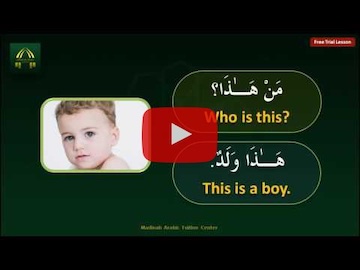Lesson 1 – الدَّرْسُ الأوَّلُ
This is… - هَـٰذَا ...
Introduction - مُقَدِّمَةٌ
- This is the first lesson in our free Arabic language course. This Arabic course with images, videos and audios will help you learn Arabic. In this lesson, we are going to learn the demonstrative articles in Arabic.
- Please read the sentences below. After completing the sentences we shall go over the rules for this lesson.
- In Part 1 of Lesson 1 we learn how to use the pronoun هَـٰذَا which means 'This' (called the demonstrative pronoun in grammar). /Hādhā/ is pronounced هَاذَا but is written without the first /alif/. The second word is the noun (object) being referred to, e.g.: بَيْتٌ means house.
Please click on the words to hear speech, i.e. how the words should be pronounced.
|
|
|
|
|
| This is a book | This is a mosque | This is a door | This is a house |
- Arabic has no word which is equal to the English word "is" which is referred to as a “copula” in grammar. We can see this rule demonstrated above where we see the words for هَـٰذَا and the noun/predicate مَسْجِدٌ being referred to without any copula. i.e. هَـٰذَا مَسْجِدٌ If read literally this sentence would read "This a mosque", however, the word "is" can be implied in this sentence so that it reads "This is a mosque".
- There is no word in Arabic corresponding to "a" in English as in: "This is a book". The n-sound, i.e. the /tanwīn/ (doubled vowel sign) at the end of the Arabic noun (kitābu-n, baitu-n, masĴidu-n) is the Arabic indefinite article corresponding to the English "a/an".
Please click on the button for part 2 below to move onto the next section where we will practice this principle further In-Shā’-Allâh (God-willing).
Part
1
2
3
4
5
6
7
8
9
10





